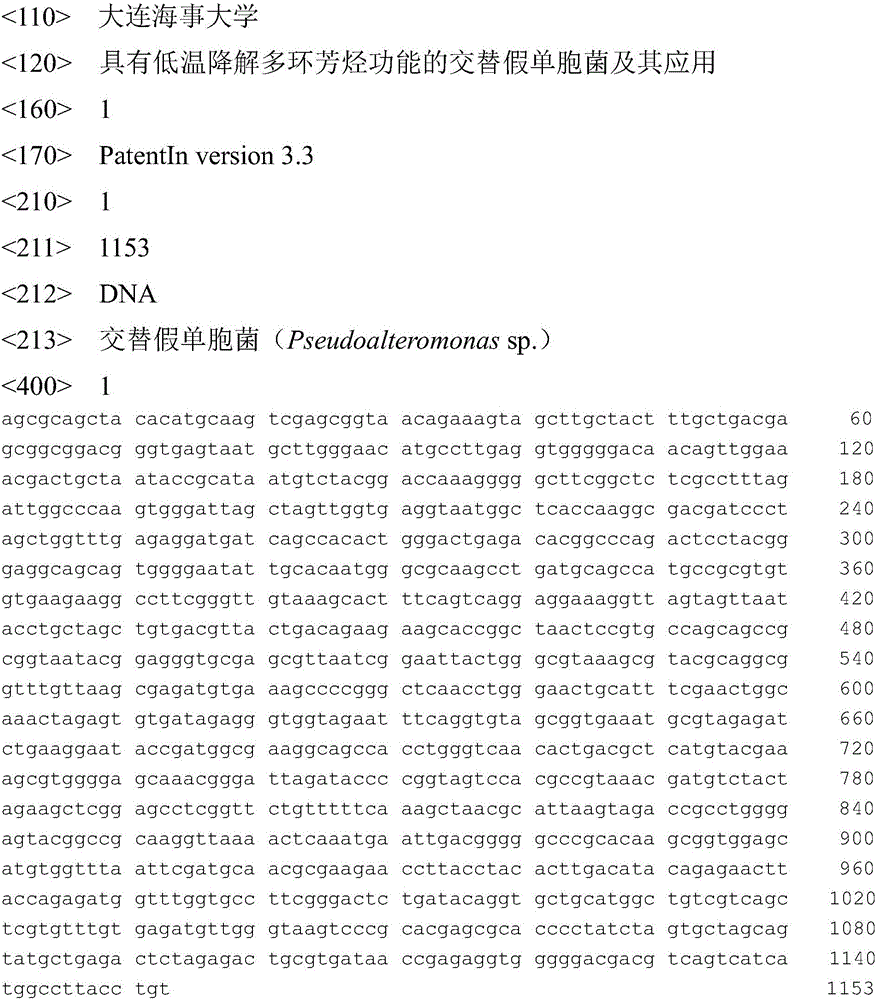Pseudoalteromonas with low-temperature polyaromatic hydrocarbon degradation function and application of pseudoalteromonas
A technology of alternating pseudomonas and polycyclic aromatic hydrocarbons, applied in the field of microorganisms, can solve problems such as lack of research results, and achieve the effect of simple culture method and strong naphthalene degradation ability
- Summary
- Abstract
- Description
- Claims
- Application Information
AI Technical Summary
Problems solved by technology
Method used
Image
Examples
Embodiment 1
[0019] Example 1 Isolation and identification of bacterial strain Pseudoalteromonas sp.QN-1
[0020] Isolation of Strain Pseudoalteromonas sp.QN-1
[0021] (1) Sample collection: Jiaozhou Bay;
[0022] (2) Enrichment and acclimatization: Add 100 mL of MMC culture solution into a 250 mL Erlenmeyer flask, and sterilize at 120° C. for 15 min. Dichloromethane was sterilized by filtration with a 0.22 μm pore size organic solvent-resistant filter membrane. Weigh 0.2g of naphthalene and dissolve it in 20mL of sterilized dichloromethane, then transfer it to 100mL of sterilized MMC culture medium, and shake it on a shaker overnight to volatilize the dichloromethane. After dichloromethane volatilizes, add 5 mL of seawater sample, place it in a low-temperature biochemical incubator, shake and cultivate at 120 r / min, 10 ° C for 30 days, and then take 5 mL of culture solution from it and transfer again: add 5 mL of culture solution to the solution containing 0.2 g Naphthalene in 100mL M...
Embodiment 2
[0027] Fermentation of Example 2 bacterial strain Pseudoalteromonas sp.QN-1
[0028] Use a sterile inoculation loop to pick up the purified bacterial lawn into a conical flask filled with 100mL of sterilized 2216E liquid medium, and culture it under low temperature shaking for 7 days (0°C, 120r / min) to become a seed solution; The liquid was added into the 2216E liquid medium at a volume ratio of 10%, and cultured at 0° C. for 7 days to obtain a fermentation liquid.
Embodiment 3
[0029] Example 3 Determination of Naphthalene Degradation Rate of Bacterial Strain Pseudoalteromonas sp.QN-1 at 0°C
[0030] (1) Degrading bacteria seed solution
[0031] Use a sterile inoculation loop to pick up the purified bacterial lawn into a conical flask filled with 100 mL of sterilized 2216E liquid medium, and culture it with shaking at low temperature for 7 days (0°C, 120r / min).
[0032] (2) Degradation culture
[0033] Weigh 0.2g of naphthalene and dissolve it in 20mL of filter-sterilized n-hexane, transfer it to a conical flask filled with 100mL of sterilized MMC liquid medium, place it on a shaker and vibrate until the n-hexane is completely volatilized, according to 10% of the inoculation amount was used to inoculate the seed solution of the degrading bacteria, and the culture was shaken at low temperature for 30 days (0° C., 120 r / min). The culture medium not inoculated with degrading bacteria was used as the blank group.
[0034] (3) Extraction
[0035]After...
PUM
 Login to View More
Login to View More Abstract
Description
Claims
Application Information
 Login to View More
Login to View More - R&D
- Intellectual Property
- Life Sciences
- Materials
- Tech Scout
- Unparalleled Data Quality
- Higher Quality Content
- 60% Fewer Hallucinations
Browse by: Latest US Patents, China's latest patents, Technical Efficacy Thesaurus, Application Domain, Technology Topic, Popular Technical Reports.
© 2025 PatSnap. All rights reserved.Legal|Privacy policy|Modern Slavery Act Transparency Statement|Sitemap|About US| Contact US: help@patsnap.com

